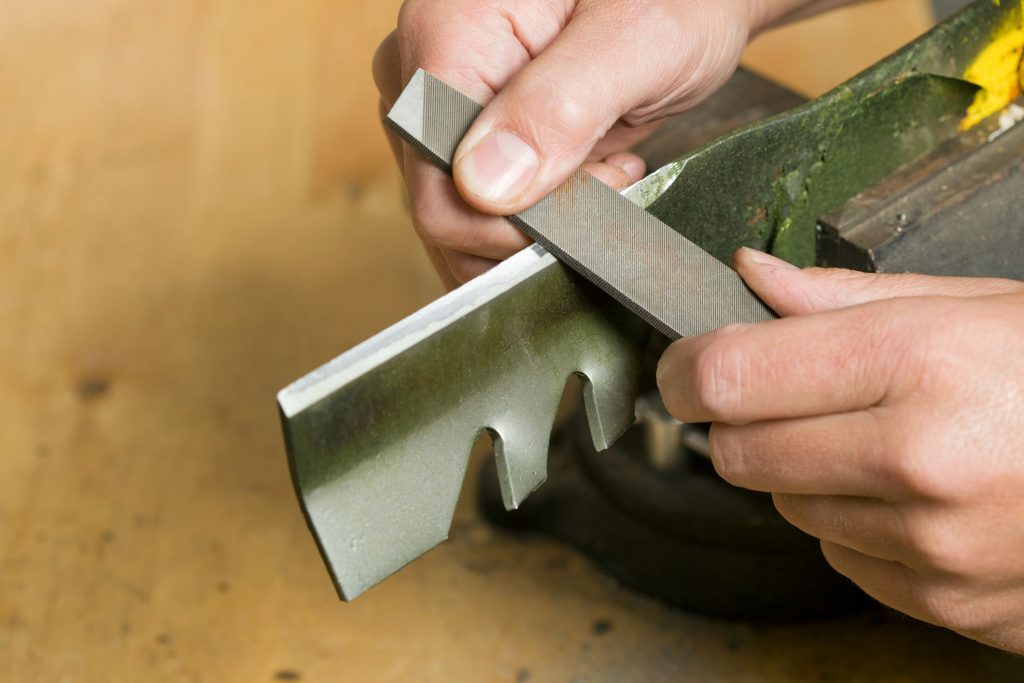The key to achieving a clean cut each time you run the mower over your lawn is to have sharp lawnmower blades, and ideally you should be sharpening the blade on your mower twice during the main cutting season.
Whatever your DIY skill level, by following the advice in this guide, you’ll be able to ensure your mower’s blade is perfectly sharp and the cut of your lawn precise and clean.
Why Should You Sharpen Your Blade:
Over time as a result of general usage, the blade on your lawnmower can become blunt. If it is subjected to contact with stones, twigs or other debris the blade can also become dented and damaged.
Continuing to cut your lawn with a damaged blade, even the slightest nick, runs the risk of you damaging your lawn rather than cutting it – and this will hinder the overall look of your garden and can also lead to irreversible damage.
Sharpening your lawnmower blade can easily be done at home – whatever our DIY skill level – by following the advice outlined in this guide.
Safety First:
Whenever it comes to carrying out any repair or maintenance work on your lawnmower, it’s important to make sure it is switched off and disconnected from the mains (if an electric mower) or the spark plug is disconnected (petrol mower). To disconnect the spark plug, remove the prominent wire from it.
Removing the Blade:
Before you can begin to sharpen the blade, you’ll need to remove it from the lawnmower by…
Clean Before Sharpening:
With the blade removed from the lawnmower, it’s a good idea to make sure you give it a thorough clean. This will remove any grass clippings and grim which have become imbedded on the blade and also make the task of sharpening your blade instantly easier.
To clean your blade use a clean cloth dipped in hot soapy water and wipe the blade to remove any dirt, before using a clean, dry cloth to dry the blade as this will prevent any rust from forming.
Once you’ve cleaned your blade, give it a once over for any nicks or damage. If your blade is suffering from a few minor nicks you can continue to sharpen it. However, if there are a number of larger nicks, the blade is bent or cracked then you’ll need to purchase replacement lawnmower blades.
How to Sharpen Your Lawnmower Blade:
As already touched upon, sharpening your lawnmower blade is relatively straightforward.
Firstly, place it securely into a bench vice to ensure it doesn’t move as you begin sharpening. Once it is secure, you can use a metal file to begin the sharpening process. Simply push the file down the blade, going along the edge of the blade until you achieve a clean, shiny edge.
After you’ve sharpened one edge of the blade, switch the blade around in the vice and sharpen the other side in the exact same manner, again until you receive a clean, shiny edge. It is worth noting that your blade doesn’t need to be razor sharp in order to be effective. Sharpening it to the sharpness of a butter knife will suffice.
Tip: When filing the blade, it’s important to make sure you keep the angle that is already on the blade. This may vary from manufacturer to manufacturer, but the angle of blade is the one which has been determined to be most effective for cutting the lawn and keeping a sharp edge.
Once you’ve finished sharpening the blade, before placing it back onto the lawnmower it is important to balance it. You can test the balance of your now sharp blade, by clamping a screwdriver to your work bench, so that it overhangs, before placing the blade on the screwdriver. If one side of the blade droops it is unbalanced, and you’ll need to file some of the blade off until it becomes balanced.
Reattach the Blade and Mow:
With a sharp, balanced blade achieved all that’s left to do is to reattach it to the lawnmower, by reversing the steps taken to take the blade off. Remember to check the side which you earlier marked is facing downwards once your mower is upright – as this will ensure that your lawnmower is able to achieve the perfect cut.
Taking the time to sharpen your lawnmower blade during the mowing season will help to ensure that you’re able to achieve a clean, neat cut each time you tackle the lawn. It’ll also help to ensure you continue to get the best performance out of your appliance – helping it last for longer.

